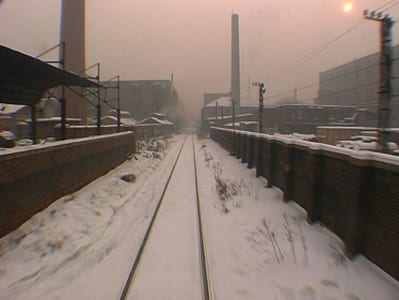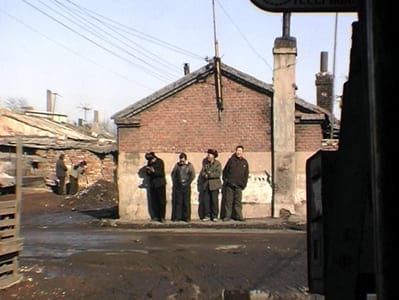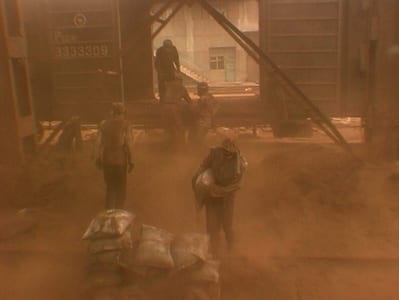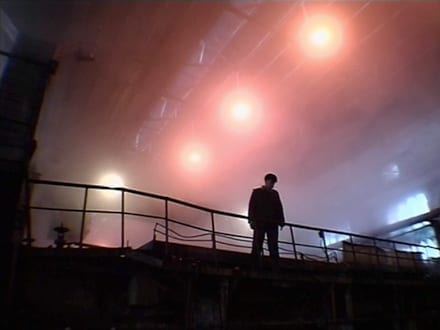* Originally published at Cinética in May 2008.
|Time traveler|
Shenyang is being dismantled. Once an industrial center which produced armaments for the Japanese army, the city was repurposed around a steel industry with the Cultural Revolution. Home to more than 2 million Chinese, Shenyang is observed by Wang Bing between 1999 and 2001. In the meantime, factories close, families are displaced, and the rails, an integral player in the city’s daily movement, are gradually marginalized from the local economic life. Wang Bing records this gradual disintegration in Tie Xi Qu: West of the Tracks, breaking it down in three parts: Rust, about factories; Remnants, about the residents; and Rails, about the trains. This structure is more focused on creating a geographic map than thematic clips. The issues Tie Xi Qu documents are far greater than the environments each part focuses on, so what we see on screen are only reflections of a much wider process that society is undergoing. At the end of the 9 hours of Wang Bing’s debut documentary, one doesn’t get three complementary portraits, but a single film in which the accumulation and circulation of visual and narrative elements are vital to generate a clear impression of the whole. The movie splits threeway, yet the title for each part could easily be shuffled, and we’d still find signs of their presence in each individual chapter.
Rails

The opening shot encapsulates many of the intentions in Wang Bing’s approach: with the camera rigged to a train (the eye of the train), we travel through Shenyang following the railroad. The camera moves through the city at a surprisingly slow pace, always looking ahead, never turning its neck with a pan or any lateral movement that’d oppose what the rails have determined. This shot is a synthesis of the process this specific location is going through, but also of the way Wang Bing will relate to the slice of the world he’s chosen to film. The first realization that comes from the opening shot is connected to the director’s paradoxically judicious gaze: once we know we are before a 9-hour long film, it is difficult to find a single shot that does not add a new perspective to the previous ones, a new angle to the situation being filmed. West of the Tracks is a film of awe-inspiring economy, because even though its running time has a weight, in the film’s diegesis it is reduced to the absolutely essential. If we spend several minutes watching workers carrying bags of ore, it is because the dramatic meaning of the activity can only be fully experienced in the final seconds of the shot.
The “eye of the train” says a lot about the filmmaker’s absolute certainty of what’s of interest to him in everything he films, about his conviction to not look away at the wrong time. There is a remarkable predisposition for the unpredictable to enter each shot, but this availability is only productive because Wang Bing knows exactly where to point his camera in whatever space he’s in. Through the semi-automatic mini-DV handycam, one finds a director of rigorous precision in his framing, in his capacity to productively crop the world with the borders of the picture, always guaranteeing that this selection generates relations and creates meaning through the physical position of the visual vectors.
But the second evidence to be fished out of the first shot is its pace: Wang Bing has an almost ritualistic respect for everything he films, and his approach is as much fruit as it is evidence of it. This respect is not really driven by the illusion that the camera might gradually “disappear,” but instead it allows the characters to get comfortable with its presence – which is a radically different thing. Although the intimacy is evident in the uncomplicated nudity of the factory workers in Rust, it is telling that the very register of the film’s apparatus changes as the camera is further acknowledged as part of the characters’ daily life. While at first the people in the film are observed from a distance, the very presence of the camera gradually allows them to perceive the singularity of the historical moment they are living. As the film progresses, they start seeing the camera not only as an observer, but as a recording tool, and then they start speaking with it – or rather to it.
However, there is a third layer in the first shot which encompasses the symbolic nature that also determines the position of the director in relation to what is being filmed: the feeling that time is passing. In this case, the richness of duration is felt not as much within a shot (as is the case of his second feature, Fengming – A Chinese Memoir), but rather in a process that is sewn together with the recurrence of that first image. The same shot from the train returns later in the film, but the tranquility and fluidity of that first appearance are replaced either by a faster pace or, even later, by the encounter with an obstacle that prevents the train from following its path. The train – the machine that best embodies the ethos of the industrial revolution, as well as the bourgeois drive towards expansion which has generated, among other things, cinema itself – appears as a metaphor for the dissolution of that society. We are witnessing a world that’s dying – and the infinitive, here, is absolutely essential. The acceleration of the train eight hours after we first saw (through) it provides an image to the rhythm of a process that had gone from contemplative slowness to vertigo-inspiring rush. In West of the Track, time is a vessel for a degradation that can only be fully understood if we, spectators, are also submitted to it.
Remnants

In its second part, the film leaves the world of the steelworkers behind and follows the life of the teenage population in one of the city neighborhoods. The camera watches them get lost in the maze of their romantic adventures, their family relations, in dead moments which are full of life. The viewer is not given any information about the characters (credits are limited to names we will quickly forget), or anything that could turn them into metonymic presences within a particular social context. Wang Bing does not judge or denounce the conditions they live in. If the place carries signs of precarity, the film seems to look beyond them so that the space can be perceived as a collection of homes, rather than as a single organism. For a long time, we are invited to observe these people in their movement. The key to dismantling the apparently aleatory nature of that observation is dropped casually during a conversation: one of the guys interrupts the chit-chat and asks one of his buddies if his house was featured on the list of demolitions planned by the government. His friend says yes.
West of the Tracks is built from the installation of the gaze, the experience of a daily life which is as determined by time as any other. It is a film about duration – a word that comes to mind both for its etymological root (to find out what’s strong enough to last, one must endure a process of dissolution), and by Bergson’s philosophical definition of the concept, in which every slice of movement expresses a change in the duration, a change in the whole. In order to have an approximate grasp of the weight of these evictions, we must first intimately get to know what will be lost. Only after an hour hanging out with these teenagers can we have a clearer understanding, a more palpable feeling, of everything that will be destroyed, of all that will cease to exist with that external intervention.
Here, Wang Bing’s controlled incorporation of chance as part of his creative process is once again essential, for a scattered conversation gains the power to re-signify everything we’d seen until then. Little by little, we realize that this mutual influence happens both between two shots and between the various elements within a single shot. Once the spectator is tuned to the beat of that existence, everything gains the weight of a metaphor, of symbolic pertinence. After hearing an old man say that the Chinese youth lived in a limbo between full identification with the regime (the case of his generation) and the will to revolt against it, the voice of a young woman who sings out of frame about how “falling in love is easy, it is harder to stay in love” oozes in as a metaphor for the entire relationship between the citizens and the Chinese state.
In a film on the deterioration caused by time, the linear editing highlights the remnants not as survivors, but as artifacts of a dead time that disturb the landscape of the present. Whether it’s the last shack that stands out against the horizontality promoted by the demolitions, the nationalist songs that the elders sing in the karaoke, or the huge abandoned factories that outlast their original functions (Wang Bing’s rationale in Brutality Factory, his episode in the 2007 anthology film The State of the World), in West of the Tracks the landscape seems to be nothing more than stacks of stories that time has progressively smashed to the ground.
Rust

The image that perfectly embodies the cumulative nature of the passing of time is suggested in the title of the first part of the film: Rust. For rust is the surface of a new time deposited over an earlier time, slowly eroding it without completely destroying it, at least not at once; there is something that lies beyond the present, under the thick layer of the now. Rather than a punctual critique of a specific path taken by the course of history, Wang Bing seems interested in pondering on the very idea of history, or the very idea of time: West of the Tracks is so markedly linear because rust is something that grows progressively, day after day.
It is rust which remains at the center of the strongest image of the film: after an entire community has been steamrolled, one remaining resident drags around scraps of metal he has picked up from the piles of debris that now cover the old neighborhood. Among them, there is one metal plate identical to those produced by the now deactivated assembly lines, which still working in full steam in the first part of the film. Then, we’d seen hundreds of brand new plates popping out of the factories; now, they appear bent, broken, and rusty. This unique ability to condense the historical shifts of an industrial empire as well as the complex relations between space and time in cinema into a single image is what makes West of the Tracks one of the most impressive debuts in recent cinema.
* * *

Passageiro do tempo
Shenyang é uma cidade em desmonte. Outrora pólo militar na fabricação de armamentos para o exército japonês, a cidade torna-se centro siderúrgico com a Revolução Cultural. Lar para mais de 2 milhões de chineses, Shenyang é observada por Wang Bing entre 1999 e 2001. Nesse meio tempo, fábricas fecharão, famílias serão desalojadas e os trilhos, tão presentes no movimento da cidade, serão, aos poucos, marginalizados da vida econômica local. Wang Bing registra essa falência múltipla em Além dos Trilhos (Tie Xi Qum, China, 2003), dividindo-a em três partes coincidentes: Ferrugem; sobre as fábricas; Remanescentes; sobre os moradores; e Trilhos. A divisão, porém, é mais uma opção de estruturação espacial do que de recorte temático. As questões, em Além dos Trilhos, são maiores do que os ambientes em que o filme se encerra e, por isso, o que vemos na tela são apenas reflexos desse processo mais amplo da sociedade. Não existem, nas 9 horas do longa de estréia de Wang Bing, três filmes complementares, mas sim um filme só em que o acúmulo e a circulação de elementos visuais e narrativos são necessários para a impressão do todo. Um filme dividido em três partes, mas partes que refletem questões tão maiores, que seus subtítulos podem ser deslocados para impressões que transbordam seus limites em tela.
Trilhos

O primeiro plano de Além dos Trilhos encapsula muitas das intenções da abordagem de Wang Bing: com a câmera instalada na frente de um trem (o olho do trem), cortamos Shenyang pela linha férrea. A câmera passeia pela cidade em velocidade surpreendentemente lenta, com os olhos fixos em frente, sem nunca girar o pescoço com uma panorâmica ou um movimento lateral que se contraponha à determinação dos trilhos. Esse plano é tanto síntese do processo pelo qual passa aquele lugar, como da maneira que Wang Bing se relacionará com o universo que ele escolhe filmar. Em primeiro lugar por Além dos Trilhos impressionar, paradoxalmente, pelo olhar absolutamente criterioso de diretor: uma vez sabendo estarmos diante de um filme de 9 horas de duração, é difícil achar um plano que – seja na composição ou na duração – não traga uma nova perspectiva, um novo dado sobre a situação que está sendo filmada. Além dos Trilhos é de uma economia espantosa, pois se seu tempo absoluto tem um peso, em sua diegese ele é reduzido ao absolutamente essencial. Se passamos vários minutos observando trabalhadores carregando sacos de minério, é porque essa atividade ganha um significado que só é encontrado nos segundos finais do plano.
O “olho do trem” diz muito sobre a absoluta certeza do realizador de o que lhe interessa em tudo que filma, sobre sua convicção em não olhar para o lado na hora errada. Existe uma abertura enorme para que o imprevisível entre na filmagem, mas esta abertura só é produtiva por Wang Bing saber exatamente para onde apontar sua câmera em qualquer ambiente em que se instala. Pela handycam mini-DV com foco e diafragma funcionando automaticamente, percebemos um diretor absolutamente rigoroso em seus enquadramentos, em sua capacidade de recortar o mundo com os limites do quadro, garantindo, sempre, que esse recorte estabeleça relações e crie sentidos a partir da disposição física dos vetores enquadrados.
A segunda evidência do primeiro plano está em sua lentidão: Wang Bing tem um respeito quase ritualístico por tudo que filma, e sua aproximação é tanto fruto quanto evidência desse sentimento. Esse cuidado, porém, não é movido pela ilusão de se fazer invisível, mas sim de permitir que seus personagens se sintam à vontade com a presença da câmera – o que é radicalmente diferente. Embora a intimidade alcançada pelo diretor fique evidente nos despudorados planos de nudez dos trabalhadores das fábricas em Ferrugem, mais reveladora é a maneira como o dispositivo do filme vai se transformando na medida em que a presença da câmera se torna conscientemente mais natural. As personagens, que, até então, limitavam-se a serem observadas, passam a perceber, pela presença da câmera, a singularidade do momento histórico em que estão inseridas. Aos poucos, elas compreendem a câmera como ferramenta de registro, e passam a, espontaneamente, falar diretamente com ela – ou melhor, para ela.
Existe, também, um caráter simbólico nesse plano inicial que marcará uma terceira posição do realizador em relação ao que é filmado: a apreensão do tempo que passa. Esse tempo, porém, não é tanto sentido dentro de um mesmo plano (como ele trabalhará em seu segundo filme, Fengming – Memórias de um Chinesa), mas sim em um processo que é costurado por essa primeira imagem. Mais tarde, o mesmo plano do trem retornará, mas a tranqüilidade e a fluidez da tomada inicial serão substituídas ou por um ritmo mais acelerado ou, ainda depois, pelo encontro com um obstáculo que impede o trem de seguir seu caminho. O trem – máquina suprema da revolução industrial e do espírito expansivo burguês que gerou, entre outras coisas, o próprio cinema – aparece como metáfora do processo de dissolução daquela sociedade. Estamos a ver um mundo a morrer – e o infinitivo, aqui, é absolutamente essencial. A aceleração do trem, oito horas depois daquele primeiro plano, vem representar em imagem o ritmo de um processo que, nos dois anos que Wang Bing o acompanhara com sua câmera, saíra da morosidade para a absoluta vertigem. O tempo, em Além dos Trilhos, é um tempo de degradação que só pode ser compreendido se passarmos, nós espectadores, também por ele.
Remanescentes

Na segunda parte de Além dos Trilhos, saímos do universo dos trabalhadores siderúrgicos e acompanhamos, em uma vila da cidade, a vida dos adolescentes. Observamos seus labirintos amorosos, suas vidas familiares, seus tempos mortos cheios de vida. Não recebemos qualquer tipo de orientação de quem são aquelas pessoas (os créditos limitam-se a dar nomes que rapidamente esqueceremos), ou qualquer informação que as situe como personagens alegóricos de um determinado contexto social. Wang Bing não faz julgamento ou denúncia sobre a situação em que elas vivem. Se chegamos à miséria pelo contraste com o mundo em que vivemos, é uma impressão que passa assim que Wang Bing determina que o importante é enxergarmos aquele espaço mais como um conjunto de lares do que como um organismo. O que existe é um convite a, de fato, observá-las em seu movimento. A chave para desmontar a aparente aleatoriedade vem em uma conversa montada de forma a conservar sua casualidade: interrompendo a descontração do papo entre amigos, um dos rapazes pergunta para outro se sua casa não está na lista de demolições do governo. Ele responde que sim.
Além dos Trilhos é construído, sobretudo, pela instalação do olhar, pela vivência de um quotidiano que é, como qualquer outro, determinado pelo tempo. É um filme sobre a duração – palavra que pode ser pensada tanto por sua raiz etimológica (pois para conhecermos o que dura, precisamos passar pelo que não sobrevive ao processo), quanto pela definição de Bergson, e a idéia de que toda fatia de movimento exprime a mudança da duração, do todo. Para termos uma impressão aproximada do peso dessas demolições, é preciso que conheçamos o que será perdido. Só depois de uma hora participando da vida daqueles jovens é que teremos uma impressão mais completa de tudo que será destruído, de tudo que deixará de existir com aquela intervenção em seus lares.
A abertura controlada de Wang Bing em relação ao acaso se mostra novamente essencial, pois uma pequena conversa é capaz de ressignificar tudo que havíamos visto até então. Pouco a pouco, percebemos que essa dupla influência acontece tanto na relação entre dois planos como entre os vários elementos dentro de um único plano. Pois, uma vez o espectador colocado em sintonia com aquela existência, tudo que é mostrado ganha peso de metáfora, de simbolismo. Depois de ouvirmos um senhor de idade dizer que os jovens chineses estariam em um limbo entre a identificação completa com o regime (caso de sua geração) e a revolta contra essa instituição, a voz de uma jovem que, fora de quadro, canta uma canção sobre como “se apaixonar é fácil, o difícil é manter” se constrói como metáfora para toda a relação entre cidadãos e Estado que vemos em tela.
Em filme construído a partir da deteriorização causada pelo tempo, a linearidade da montagem ressalta os remanescentes não como sobreviventes, mas como artefatos de um tempo morto que perturbam a paisagem do presente. Seja pelo último barraco que se pronuncia à horizontalidade das demolições, pelas canções nacionalistas que os mais velhos cantam no karaokê, ou pelas gigantescas fábricas abandonadas que duram para além de suas funções originais (raciocínio que Wang Bing aprofundaria em Brutality Factory, seu episódio no filme coletivo O Estado do Mundo), a paisagem, em Além dos Trilhos, parece não ser mais do que o empilhamento das histórias que o tempo, progressivamente, pôs ao chão.
Ferrugem

A imagem perfeita para esse tempo que passa está sugerida no título da primeira parte de Além dos Trilhos: ferrugem. É ela a superfície de um novo tempo que se deposita sobre um tempo anterior, corroendo-o aos poucos, mas sem destruí-lo por completo de imediato; escondendo sua base sob uma camada de presente. Mais do que uma crítica pontual a um caminho tomado pelo andamento da história, Wang Bing parece interessado em pensar a própria idéia de história, ou a própria idéia de tempo: existe, em Além dos Trilhos, uma preocupação aguda com a linearidade, pois a camada de ferrugem é algo que se instala progressivamente, dia após dia.
É ela, também, que protagonizará a imagem mais forte de Além dos Trilhos: ao fim da demolição de toda uma comunidade, um morador remanescente arrasta peças de ferro encontradas nos escombros da antiga vila. Entre os restos, está uma chapa metálica idêntica às produzidas nas linhas de montagem, agora já desativadas, que vemos em pleno funcionamento na primeira parte do filme. Mas, se antes vimos centenas dessas chapas saindo, estalando de novas, das fábricas, a folha do presente está retorcida e coberta de ferrugem. É por essa capacidade ímpar de condensar o devir histórico de um império industrial e a relação espaço-tempo do cinema em uma mesma imagem que Wang Bing concretiza, em Além dos Trilhos, uma das estréias mais impressionantes do cinema recente.






Leave a Reply